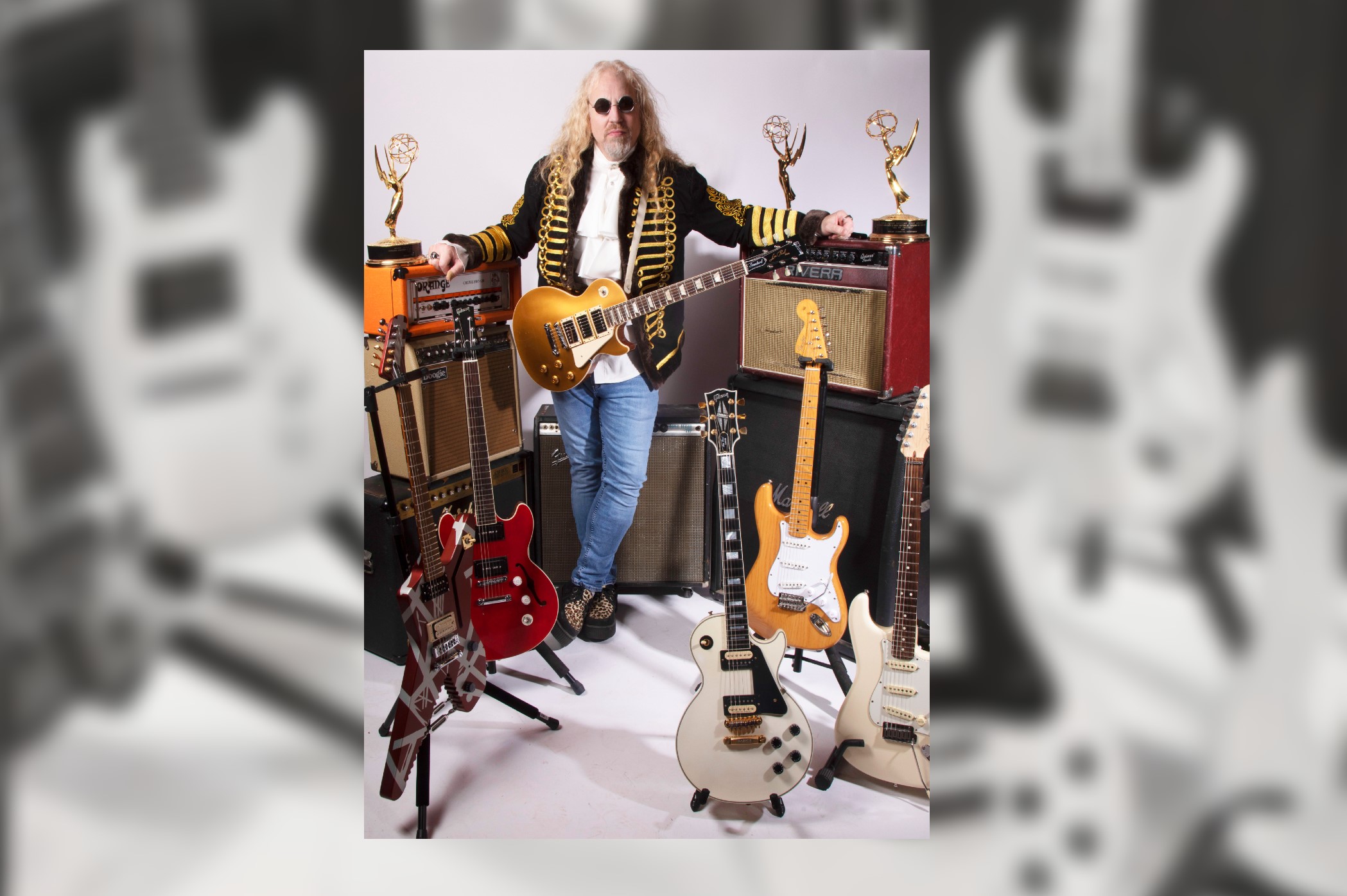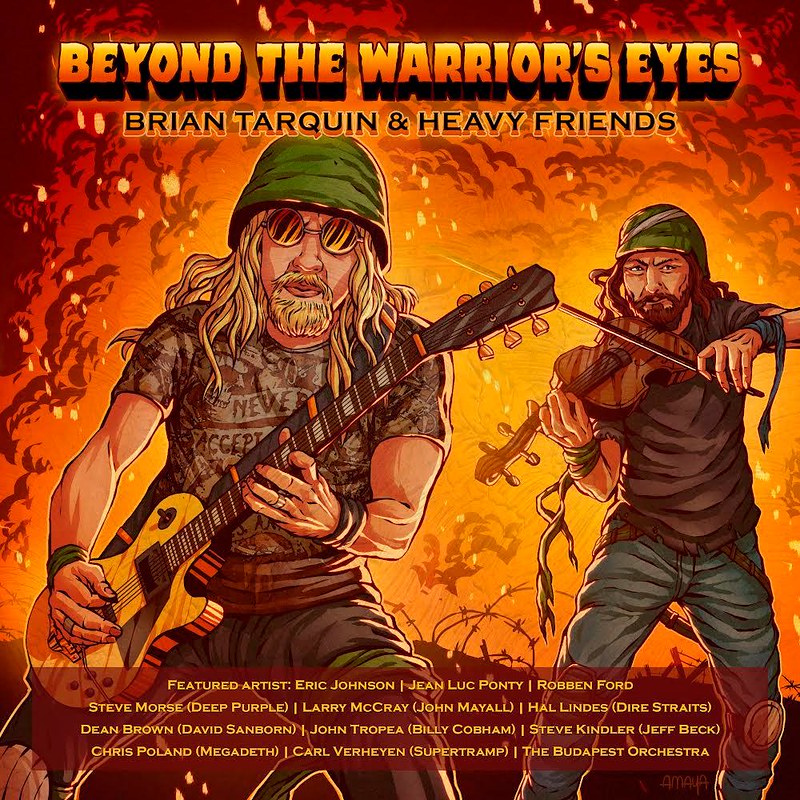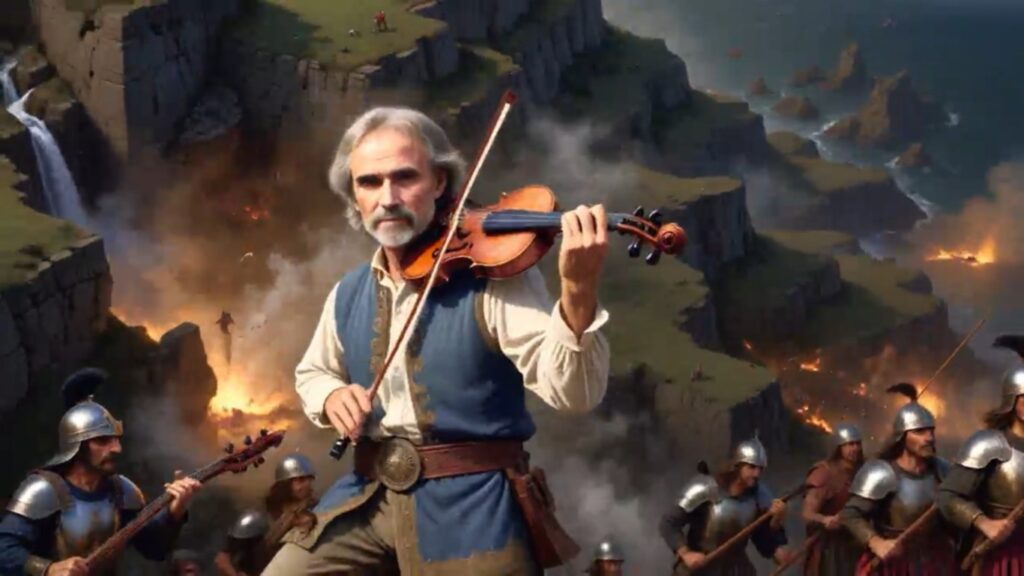
Brian Tarquin talks to Jason Barnard about his collaborations with classic rock guitarists and his newest release, “Beyond The Warrior’s Eyes” which also features violinist Jean Luc Ponty and the late rock singer Phil Naro (Talas, Peter Criss). With a career spanning decades, Brian reflects on the evolution of the music industry, emphasising the enduring importance of genuine collaboration. Looking ahead, future projects promise to continue making a positive impact, with plans for a new EP featuring Joe Satriani and Gus G in the works.
‘Beyond The Warrior’s Eyes’ is a remarkable fusion of musical talents aimed at honouring veterans. What inspired you to embark on such a meaningful project, particularly focusing on veterans’ support?
I have always had a special spot in my heart for military veterans. I feel they have always been forgotten in our world and taken for granted. I remember seeing homeless Vietnam veterans living in the subway and streets of New York City where I grew up in the ‘70s. It was a disgraceful sight because at that time no one seemed to care about veterans. So, I wanted to draw as much attention as I could to veteran’s needs and what better way than through music.
My father was a World War II veteran serving in the South Pacific from 1943-1946 along with millions of other soldiers. He told many stories of his comradery with his fellow marines and how they all looked forward to the GI Bill. So, in college back in the ‘80s I joined the ROTC (Reserve Officers’ Training Corps) for a while, serving a short stint in the military and doing basic training at Fort Knox. Even though I didn’t stay in the service, I always had a deep respect for the men and woman who serve.
With veterans being at the heart of your latest album, how do you believe music can serve as a vehicle for healing and appreciation for their sacrifices?
Larry Coryell once told me in the studio that “we as musicians have to do as much as we can through our music to make people aware of social issues.” I hope that people can let their emotions take them to inner peace and happiness through listening to the music. No matter if it is pain, happiness, sadness, anguish, exhilaration, love, music has played a key role in helping me cope and keep well adjusted. Through history music has had a massive impact on society. Just think of how music shaped the 20th century with swing jazz in the ‘20s and how rock evolved from Buddy Holly in the 50’s to Metallica in the 80‘s. In fact the 60’s wouldn’t have been nearly as vibrant without the British invasion and the California scene. For me I try to create social impact through my music. I use the guitar as a paint brush on a canvas to evoke emotions.

Your latest album features an array of legendary musicians. How did you manage to bring such an impressive lineup of artists together?
For years I have had an NPR radio show called Guitar Trax on WFIT 89.5FM in Florida where I have interviewed many of the guitarists on the album, which helped to build a musical rapport between us. Some other artists I’ve met through my career like Gary Hoey, Chuck Loeb, Randy Coven, Leslie West, etc.
Steve Morse, Jean Luc Ponty, Eric Johnson, and other musicians contributed to the album. What was the collaborative process like with such esteemed artists, and how did their input influence the final record?
I have spoken to Jean Luc Ponty in detail a couple of times in the past for the and we hit it off, so I asked him if he would be willing to guest on a track for the new album. I wanted to compose something special for him and for the album to give the listener a real treat. So, as I was composing “Beyond the Warrior’s Eyes”. I wanted to paint a feeling not only of great aggression but also a scene of desperation and dramatic emotions. Sure enough Jean Luc really liked the track and within few weeks he sent me back the final solo you here in the song.
Because it is instrumental music, it can be very difficult to get across to the general public at times. There are no words or lyrics that they can relate to in the song. I always like to make the music thematic, describing some sort of story to the listener. This helps a lot to keep their attention and interest in the song. So, with all this in consideration I chose the guest artists very selectively. I concentrated on guitarists who specialize in instrumental music, because composing instrumental music is very different than writing lyrical songs. I would also compose each track specifically for that guest artist’s style. I learned this craft during my Contemporary jazz solo days, seeing how people reacted to my music, both radio music directors and listeners.

Can you share some memorable moments from the recording sessions of ‘Beyond The Warrior’s Eyes’?
I started the project before the Pandemic, doing a lot of pre-production like composing and recording basic tracks. Then during the lock down of 2020-21 I was speaking with a lot of the guests and going full bore on recording and production
Of course, there is the logistical issue of aligning everyone’s schedule for recording their parts. But doing it virtually helps because they can record their parts on their own time. The Pandemic really put everyone at home with time on their hands, so it worked out for this project. In fact, for the song “A Soldier’s Journey” I hired the Budapest Orchestra to record the string parts live in Europe. This was an elaborate process by getting proper orchestra charts and making sure all of the instruments are orchestrated correctly. Once they were recorded in Budapest, I had to fly all of the instruments into the final session and mix. It took some doing but I am extremely pleased with the final outcome.
‘Beyond The Warrior’s Eyes’ showcases a blend of intricate instrumentation and emotive performances. How do you strike a balance between technical proficiency and emotional expression in your music?
Because the majority of the album was recorded over the Pandemic, I performed all of the bass parts, rhythm guitar parts, guitar melodies and solos (other than the obvious guest solos). I used my longtime friend and session drummer Reggie Pryor. I am a stickler for detail, so the Pandemic gave me the opportunity not to rush and take my time to get sounds and tones correct.
All of the songs on the album are new compositions. I composed the majority of the songs on the guitar and usually get the song idea from playing various riffs on guitar and then working out a rough arrangement before adding other instruments. For example, the chord progression of the song “The Gates of Valhalla” featuring Eric Johnson & Dean Brown, I wrote in my living room using a Gibson Les Paul through an Orange Amp. I’m glad I was able to work with both artists; Eric has always been an inspiration and I loved Dean’s work with Billy Cobham.
Collaboration seems to be a cornerstone of your musical journey. What draws you to collaborative projects, and how do you navigate the dynamics of working with various artists?
I love collaborating with other guitarists on special projects for helpful causes. I’m always trying to outdo myself with composing and guests on my records. All of the guest guitarists are seasoned instrumentalists as well, which makes it a perfect fit. So, I wanted to create an instrumental studio version of benefit projects like ARMS Charity Concerts envisioned by Ronnie Lane for multiple sclerosis and Hear ‘n Aid by Dio for famine relief in Africa. Except Brothers In Arms is a veterans relief project.
Could you share some insights into your production process for ‘Beyond The Warrior’s Eyes,’ especially considering your extensive experience in music production?
I have a very unique mobile recording studio called Jungle Room Studios housed in a 28-foot custom made trailer. It was designed in Southern California equipped with 2 separate rooms, a live room and a control room. I really think that analog sounds rich and vibrant. But to take advantage of technology I use both analog and digital to record, the best of both worlds. I have a very unique mobile recording studio called Jungle Room Studios housed in a 28-foot custom made trailer. It was designed in Southern California equipped with 2 separate rooms, a live room and a control room. The studio features a modified 1986 British Trident 24 recording console, an Otari MTR 90 2” Analog Tape Machine, a Ampex 440c 1/4” 2 track analog tape machine, and a variety of classic outboard gear such as, the Neve Compressor 33609, Rupert Neve Designs Portico II Master Buss Processor, Neve 1074, Chandler ltd Germanium Compressor, and a host of other gear.
MICROPHONES
I would use the following microphones to record the amps, some in a live room and some in the amp booth. Beyerdynamics M160 Ribbon, Royer R101, SE Voodoo VR-1, Sennheisser 609, Electro Voice RE20 Cardioid Dynamic, Sennheiser MD-421, SE Z5600a II Tube Microphone, SE RT1-Ribbon Tube Microphone, AKG D112 Large Diaphragm Microphone. However, one of my favorites is always been the Beyerdynamics M160 Ribbon for amps for its clarity and durability. I have blown many a ribbon putting it front of a Marshall cabinet.
SIGNAL CHAIN
At the center of the studio is a modified 1986 Trident 24 Series 28 channel 24 bus w/TT patch bay with a custom made GMPS 18 Power Supply. I have all of the outboard gear hard wired into the Trident’s patch bay. So, for guitars I used the BAE 1073 Mic Pre with 1084 EQ section for the microphones and then patched directly into the Otari MTR 90 – 24 track 2″ Analog Tape Machine. Sometimes I would use the Trident’s built in preamps as well, depending on the track. I would not compress going to tape, but during mixdown I used the Rupert Neve 5043 Duo Compressor/Limiter on the rhythm guitar tracks and melodies. Another favorite compressor is Chris Yetter’s Audio Scape 76A Compressor & Audio Scape 6386 EDITION V-COMP MU.
Here is a Tape Op article describing the process.
The album features a variety of musical styles, from fusion-prog to rock. How do you approach blending these genres seamlessly while maintaining the album’s cohesive narrative?
Growing up in the 60’s, 70’s, 80’s there was a plethora of great guitarists to choose from and guitar music was king! This helped me see how productions of instrumental music and guitar themes were recorded and orchestrated. I started out being really influenced by the British invasion guitarists as Eric Clapton, Jimmy Page & Jeff Beck and then moved onto Jimi Hendrix. Third Stone From The Sun was unreal and really spoke to me because I was immediately attracted to instrumental guitar music. I always loved Jimmy Page’s tone and solo in the middle of “Hearbreaker”, it was the “Eruption” of the day.
When Jeff Beck came out with his fusion solo albums Blow By Blow, Wired & There and Back I knew that was my path in life. But when I heard Jeff Beck Live with the Jan Hammer Group, that was one of the best moments. Jeff’s tone on that album is the best I have ever heard him. Live songs like “Freeway Jam”, “Blue Wind” and “Full Moon Boogie” are trail blazing performances by Jeff. In fact, I recently had the honor in working with the violinist on that album Steve Kindler for an upcoming release. Steve was originally in Mahavishnu Orchestra and is on the “Visions of the Emerald Beyond” later replacing Jean Luc Ponty in the band.
Of course, Joe Satriani showed me how to make rock instrumental music accessible to the masses. “Surfing with the Alien” what great album! That really influenced me, laying out a road map of being creative and popular.
You’ve been in the music industry since the 1980s. How have you seen the industry evolve over the years, especially in terms of collaboration and production techniques?
Back in the day I used to cut & edit tape a lot, but for this album I initially cut the basic tracks of drums, bass and rhythm guitars on 2” analog tape. Then I transferred all the tracks to digital format to edit and fly in the guest solos. Today the younger generation have bought into the idea of making music on their iPhones and laptops using premade musical loops and plug ins to alter their vocals. Cut and paste, hit the space bar, alter performances – all this has changed the way people create music, if you want to call it creating. Somehow it seems no one wants to practice actual instruments any longer, as society’s attention span has grown ridiculously short.
However, the music business has really made a metamorphosis change. Early in my career I worked at record companies in radio promotions, finance, business affairs and learned the business inside out. I was hungry for knowledge on how to make money from being a recording artist and composer. So, I understand cross-collateralized royalties, recoupment and reserves being held. I always thought if you are going to be an artist in this industry you should be required to work in it for at least a year before you sign any kind of deal. That way you are well informed to any decision you make regarding signed agreements. I even wrote a couple of books on the topic, “Insider’s Guide To Music Licensing” (Allworth Press) and “Survival Guide For Music Composers” (Hal Leonard). The whole reason I wrote them is I found most music business books were written by lawyers and are written very pretentiously. So, I wanted to write one in plain simple English terms for the average musician.
Your studio setup includes analogue tape and vintage gear. How do you believe this analogue approach contributes to the unique sound and character of your recordings?
Well for me analog tape is the real magic! I know the younger generation likes to record their parts all separately in their own spaces at their parents’ houses. But when I’m recording tracks, I want us all to be in the same room to perform together so we can vibe off each other while I’m cutting to tape. Otherwise it becomes so sterile and contrite. Unconvincing and unauthentic to my ears.
What projects do you envision for the future, and how do you hope to continue making a positive impact through your music?
I’m currently recording a new EP featuring Joe Satriani, Stu Hamm, Gus G from Ozzy and some surprise guests this year for a future release.




